Young stands with a high proportion of conifers should be thinned; this improves the future stability of our forest stands. On steep slopes, very wet sites or other rough terrain, forest managers often do not carry out these measures, however, or they wait too long before doing so. This is because such terrain is more or less inaccessible to conventional vehicles, and special technology is not available or too expensive. Is a thinning cableway a possible solution? A study was carried out using such a cableway to find out.
A small cableway for short distances
Cableway in the study
- Cableway: Small cableway from Maxwald company
- Length of corridor: up to approx. 250 m
- Carriage weight: 40 kg
- Lifting capacity: up to 1000 kg (depending on skyline)
Area covered in the study
- Stand: Mixed stand, 60-80 years old
- Location: Slopes in Altmühltal valley near Kelheim
- Inclination: 25 degree slopes on average
With cable yarder extraction, a skyline is stretched along a previously laid out corridor. If the cableway used does not have its own mast, a tree is required at either end of the route to which to attach the skyline. For the operation to be safe, these so-called tailspar trees must also be secured to other anchor trees. The skyline height depends on the features of the terrain. With long corridors or ridged terrain, it may be necessary to incorporate a passable intermediate skyline support (Fig. 1, Fig. 2). The carriage (Fig. 4) uses gravity to run down the skyline to the felled timber. The winch on the tractor maintains some tension on the haul-in line so that the carriage does not hit the carriage stop unrestrained. On the carriage, a lifting pulley bears the load, which is raised and lowered by the haul-in line (mainline). A mechanically controlled mounted cable winch moves the haul-in line and the carriage. A small standard tractor is sufficient to drive the winch. The tested small cableway is sufficient for thinning trees of small to medium size.
The cableway is operated by two people. The "machine operator" operates the cable winch at the tractor close to the storage site, sorts the timber according to category as far as possible, and releases the chain from the wood. The "attacher" in the corridor pre-bundles the wood using a cant hook and attaches it to the lifting pulley of the haul-in line. Two-way radio contact and agreed commands are essential for safe and efficient operations.
Optimising load formation for high output
The quantity of timber per load has a strong influence on output. Here is an example:
- Bundle size per load Average output
- 0.3 m³ [solid] 2.5 m³ [solid] per hour [m³/h]
- 0.8 m³ Just under 6 m³/h
Thus the more timber there is in a load bundle, the higher the output of the cableway (Fig. 3), although obviously, the maximum lifting capacity must not be exceeded.
It was not always possible during the study to load the cableway absolutely to capacity. One reason for this was the lifting pulley system in the used cableway. Once the first log has been attached, the construction of the system means that others can only be attached if they are not too far away. The maximum lifting capacity cannot therefore be exploited fully if the trunks are scattered too far apart, the felling direction is not right, or the trunks have not been bundled beforehand into suitable load sizes. The result is a lower output. The problem is exacerbated if the timber is hauled according to timber assortment. The timber should thus not be sorted until it reaches the landing point.
Keep it short!
The length of the slope determines the hauling distance; it is impossible to influence this. In planning the felling measure, it is however important to estimate the set-up time and costs of cable extraction. Here are a few benchmark values from the work study.
The length of the corridor and the hauling distance have a direct effect on the output of the cableway (Fig. 6). The longer the hauling distance, the lower the output. The influence of the hauling distance is however not as strong as that of the load size. Here is an example with the same timber quantity per load:
- Hauling distance Output
- 50 m 4 m³/h
- 200 m 3 m³/h
The time involved in setting up and taking down the cableway with two people is approx. 4-5 hours. This increases only slightly with increasing corridor length. If this is taken into account in calculating the costs per cubic metre (solid), the disadvantage of long corridors is reduced.
The hauling of the load out of the stand to the corridor also has an effect on the output. However, the time needed to haul the load to the corridor is low in relation to the total time needed for a load, and other parameters of influence weigh more heavily. In the study (20-25 m between corridors), the distance the timber had to be hauled to reach the corridor did not have a measurable effect on the output.
It is thus the quantity of timber per load and the hauling distance that have a decisive influence on the output. If we consider both factors, we end up with a matrix (Tab. 1). The felling, conversion and stacking of the extracted timber is not taken into account here.
What does the entire operation cost?
The output - and thus the costs - depend on many different influencing factors and these may vary considerably from operation to operation. Table 2 shows an example of a calculation for the complete process from felling to stacked timber at the forest road. An hourly wage of 20 €/h was assumed and a state subsidy (as in Bavaria) was taken into account.
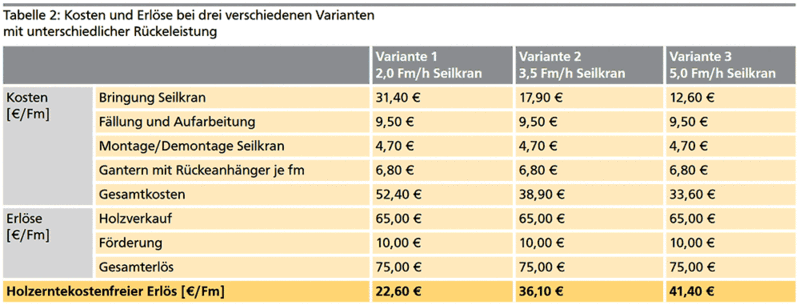
Tab. 2: Costs and revenues for three different variants with different hauling outputs.
Summary
A key outcome of the study is that the output of the cableway used is strongly influenced by the level of exploitation of the maximum lifting capacity, and the
hauling distance. This probably applies for all operations. The exact output figures of one study are not necessarily always transferable to other operations, however.
In the study, two points reduced the output of the cableway used: One was that the upper part of the slope was too flat. This meant that the gravity-driven carriage was often slow to get away from the landing at the top, so that the empty journeys back to the loading point lasted considerably longer. Secondly, with an average log diameter of 17.2 cm, the extracted trunks were so thick that it was only possible to a limited extent to bundle them into loads with the cant hook. This also led to small loads being transported.
Under more favourable conditions, the output could thus presumably be higher - something that would have to be proven in comparable work studies.
In long cableway corridors or in ridged or craggy terrain, a passable support can be deployed to ensure the height of the skyline is sufficient.

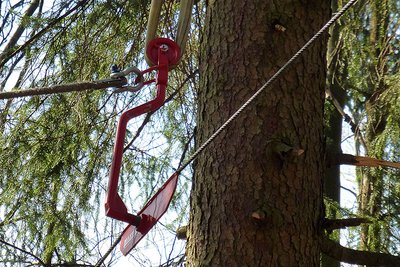
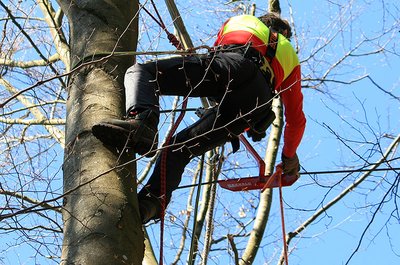
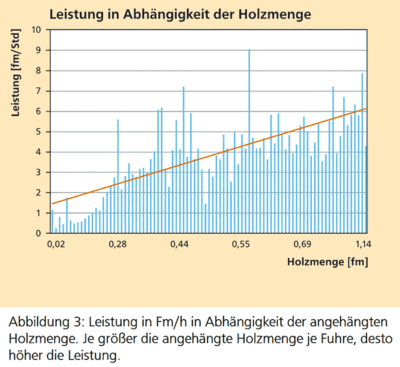
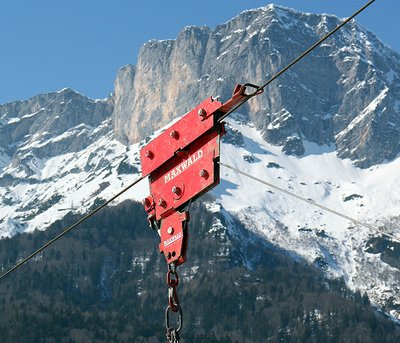
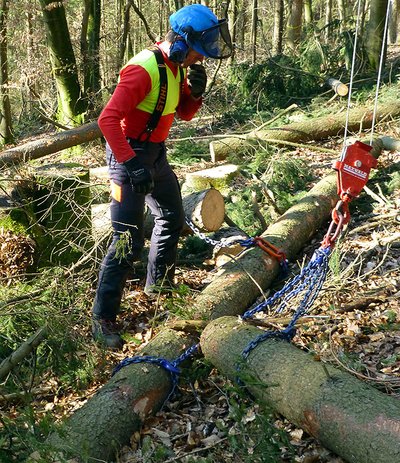
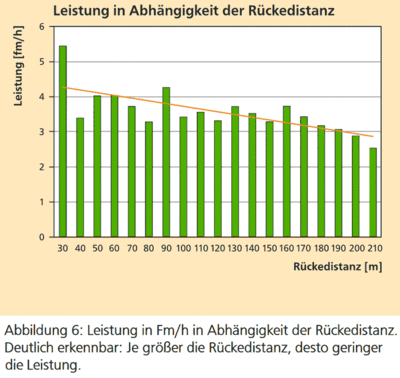
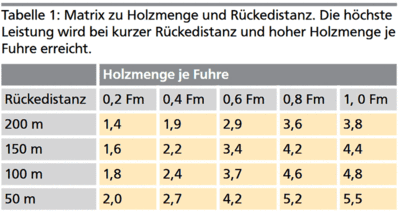
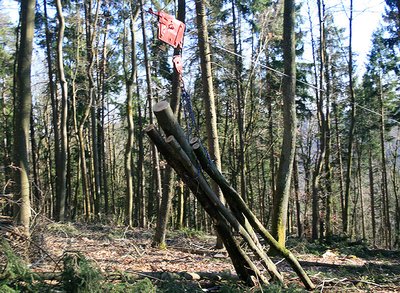
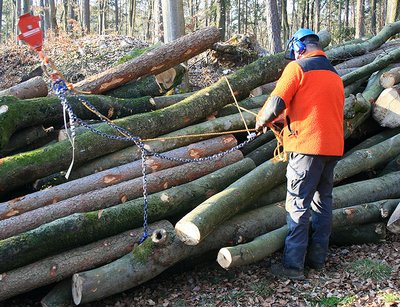
![[Translate to English:] [Translate to English:]](/assets/technik/holzernte/arbeit/wsl_holzernte_hanglagen/wsl_holzernte_hanglagen_2_gr_01.jpg)